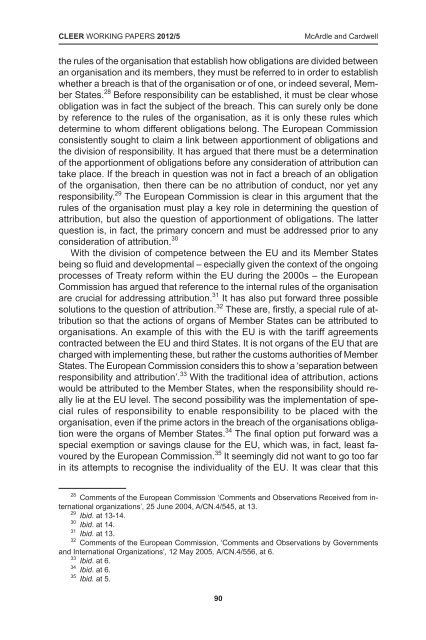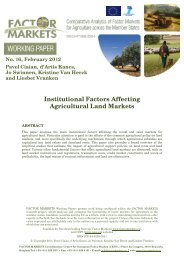CLEER WORKING PAPERS 2012/5McArdle <strong>and</strong> Cardwellthe rules <strong>of</strong> the organisation that establish how obligations are divided betweenan organisation <strong>and</strong> its members, they must be referred to in order to establishwhether a breach is that <strong>of</strong> the organisation or <strong>of</strong> one, or indeed several, MemberStates. 28 Before responsibility can be established, it must be clear whoseobligation was in fact the subject <strong>of</strong> the breach. This can surely only be doneby reference to the rules <strong>of</strong> the organisation, as it is only these rules whichdetermine to whom different obligations belong. The European Commissionconsistently sought to claim a link between apportionment <strong>of</strong> obligations <strong>and</strong>the division <strong>of</strong> responsibility. It has argued that there must be a determination<strong>of</strong> the apportionment <strong>of</strong> obligations before any consideration <strong>of</strong> attribution cantake place. If the breach in question was not in fact a breach <strong>of</strong> an obligation<strong>of</strong> the organisation, then there can be no attribution <strong>of</strong> conduct, nor yet anyresponsibility. 29 The European Commission is clear in this argument that therules <strong>of</strong> the organisation must play a key role in determining the question <strong>of</strong>attribution, but also the question <strong>of</strong> apportionment <strong>of</strong> obligations. The latterquestion is, in fact, the primary concern <strong>and</strong> must be addressed prior to anyconsideration <strong>of</strong> attribution. 30With the division <strong>of</strong> competence between the <strong>EU</strong> <strong>and</strong> its Member Statesbeing so fluid <strong>and</strong> developmental – especially given the context <strong>of</strong> the ongoingprocesses <strong>of</strong> Treaty reform within the <strong>EU</strong> during the 2000s – the EuropeanCommission has argued that reference to the internal rules <strong>of</strong> the organisationare crucial for addressing attribution. 31 It has also put forward three possiblesolutions to the question <strong>of</strong> attribution. 32 These are, firstly, a special rule <strong>of</strong> attributionso that the actions <strong>of</strong> organs <strong>of</strong> Member States can be attributed toorganisations. An example <strong>of</strong> this with the <strong>EU</strong> is with the tariff agreementscontracted between the <strong>EU</strong> <strong>and</strong> third States. It is not organs <strong>of</strong> the <strong>EU</strong> that arecharged with implementing these, but rather the customs authorities <strong>of</strong> MemberStates. The European Commission considers this to show a ‘separation betweenresponsibility <strong>and</strong> attribution’. 33 With the traditional idea <strong>of</strong> attribution, actionswould be attributed to the Member States, when the responsibility should reallylie at the <strong>EU</strong> level. The second possibility was the implementation <strong>of</strong> specialrules <strong>of</strong> responsibility to enable responsibility to be placed with theorganisation, even if the prime actors in the breach <strong>of</strong> the organisations obligationwere the organs <strong>of</strong> Member States. 34 The final option put forward was aspecial exemption or savings clause for the <strong>EU</strong>, which was, in fact, least favouredby the European Commission. 35 It seemingly did not want to go too farin its attempts to recognise the individuality <strong>of</strong> the <strong>EU</strong>. It was clear that this28 Comments <strong>of</strong> the European Commission ‘Comments <strong>and</strong> Observations Received from internationalorganizations’, 25 June 2004, A/CN.4/545, at 13.29 Ibid. at 13-14.30 Ibid. at 14.31 Ibid. at 13.32 Comments <strong>of</strong> the European Commission, ‘Comments <strong>and</strong> Observations by Governments<strong>and</strong> International Organizations’, 12 May 2005, A/CN.4/556, at 6.33 Ibid. at 6.34 Ibid. at 6.35 Ibid. at 5.90
The International Law Commission: An increasingly significant role for the <strong>EU</strong>?would not be recognised <strong>and</strong> perhaps would detract from the growing desire<strong>of</strong> the <strong>EU</strong> to pursue a role within an ‘effective multilateral’ international community.The ILC was originally not keen to establish such an exemption clause.The Special Rapporteur considered that it would be possible to draft a generalrule attributing actions that implemented binding acts <strong>of</strong> an organisationto that organisation. 36 While the ILC was, furthermore, not sure on the existence<strong>of</strong> a special rule <strong>of</strong> attribution, 37 the idea <strong>of</strong> a general lex specialis provisionwas first voiced within the reports <strong>of</strong> the Special Rapporteur in 2007, beforebeing incorporated into the draft articles in 2009. The lex specialis provision iscontained with Article 64 <strong>of</strong> DARIO <strong>and</strong> states:‘These articles do not apply where <strong>and</strong> to the extent that the conditions for the existence<strong>of</strong> an internationally wrongful act or the content or implementation <strong>of</strong> theinternational organization, or a State in connection with the conduct <strong>of</strong> an internationalorganization, are governed by special rules <strong>of</strong> international law. Such specialrules <strong>of</strong> international law may be contained in the rules <strong>of</strong> the organization applicableto the relations between an international organization <strong>and</strong> its members.’The principle is modelled on article 55 <strong>of</strong> the articles on the Responsibility <strong>of</strong>States for Internationally Wrongful Acts <strong>and</strong> is designed so that continuedreference to ‘special rules’ throughout the articles is not necessary. 38 It basicallyfollows the international law maxim lex specialis derogat legi generaliwhich considers that where more specialised legal provisions exist, they willtake precedence over general legal principles. 39The inclusion <strong>of</strong> this principle is able to show two significant developmentsin the <strong>external</strong> identity <strong>of</strong> the <strong>EU</strong>. The first <strong>of</strong> which is the way in which theopinions <strong>of</strong> the <strong>EU</strong> on this show a distinct view on behalf <strong>of</strong> the European Union<strong>and</strong> move away from any consideration <strong>of</strong> the <strong>EU</strong> simply voicing the opinions<strong>of</strong> a collection <strong>of</strong> States. The second <strong>of</strong> these developments is the influencethat the comments <strong>of</strong> the <strong>EU</strong> had. These are comments that were distinctlythose <strong>of</strong> the <strong>EU</strong>, <strong>and</strong> furthermore, they were responded to, showing an actualinfluence <strong>of</strong> the <strong>EU</strong> in the development <strong>of</strong> international law. The following sectionexplores this claim in more detail.4. The ILC <strong>and</strong> lex specialis: a result <strong>of</strong> <strong>EU</strong> opinion?The lex specialis principle within the work on the responsibility <strong>of</strong> internationalorganisations is actually relatively new. The first mention <strong>of</strong> this idea arose inthe fifth report <strong>of</strong> the Special Rapporteur, Giorgio Gaja, in 2007. He recognised36 Seventh Report on the Responsibility <strong>of</strong> international Organisations by Giorgio Gaja, SpecialRapporteur, A/CN.4/610, at 12.37 Seventh Report on the Responsibility <strong>of</strong> international Organisations by Giorgio Gaja, SpecialRapporteur, A/CN.4/610, at 38-39.38 Commentary to Draft Article 64 Draft Articles on the Responsibility <strong>of</strong> International Organizations,para. 7, Yearbook <strong>of</strong> the International Law Commission 2011, vol. II, Part Two.39 Fifth Report on Responsibility <strong>of</strong> International Organizations 2007, A/CN.4/583, para. 7,at 4.91CLEER WORKING PAPERS 2012/5
- Page 1:
Founded in 2008, the Centre for the
- Page 4 and 5:
CLEER WORKING PAPERS 2012/5Gosalbo
- Page 6 and 7:
CLEER WORKING PAPERS 2012/5Gosalbo
- Page 8 and 9:
CLEER WORKING PAPERS 2012/5Gosalbo
- Page 10 and 11:
CLEER WORKING PAPERS 2012/5Blockman
- Page 12 and 13:
CLEER WORKING PAPERS 2012/5Blockman
- Page 14 and 15:
CLEER WORKING PAPERS 2012/5Casolari
- Page 16 and 17:
CLEER WORKING PAPERS 2012/5Casolari
- Page 18 and 19:
CLEER WORKING PAPERS 2012/5Casolari
- Page 20 and 21:
CLEER WORKING PAPERS 2012/5Casolari
- Page 22 and 23:
CLEER WORKING PAPERS 2012/5Casolari
- Page 24 and 25:
CLEER WORKING PAPERS 2012/5Casolari
- Page 26 and 27:
CLEER WORKING PAPERS 2012/5Casolari
- Page 28 and 29:
CLEER WORKING PAPERS 2012/5Casolari
- Page 30 and 31:
CLEER WORKING PAPERS 2012/5Casolari
- Page 32 and 33:
CLEER WORKING PAPERS 2012/5Casolari
- Page 34 and 35:
CLEER WORKING PAPERS 2012/5Casolari
- Page 36 and 37:
CLEER WORKING PAPERS 2012/5Casolari
- Page 38 and 39:
CLEER WORKING PAPERS 2012/5Casolari
- Page 40 and 41:
CLEER WORKING PAPERS 2012/5Van Elsu
- Page 42 and 43: CLEER WORKING PAPERS 2012/5Van Elsu
- Page 44 and 45: CLEER WORKING PAPERS 2012/5Van Elsu
- Page 46 and 47: CLEER WORKING PAPERS 2012/5Van Elsu
- Page 48 and 49: CLEER WORKING PAPERS 2012/5Van Elsu
- Page 50 and 51: CLEER WORKING PAPERS 2012/5Van Elsu
- Page 52 and 53: CLEER WORKING PAPERS 2012/5Van Elsu
- Page 54 and 55: CLEER WORKING PAPERS 2012/5Van Elsu
- Page 56 and 57: CLEER WORKING PAPERS 2012/5Van Elsu
- Page 58 and 59: CLEER WORKING PAPERS 2012/5Van Elsu
- Page 60 and 61: CLEER WORKING PAPERS 2012/5Van Elsu
- Page 62 and 63: CLEER WORKING PAPERS 2012/5Van Voor
- Page 64 and 65: CLEER WORKING PAPERS 2012/5Van Voor
- Page 66 and 67: CLEER WORKING PAPERS 2012/5Van Voor
- Page 68 and 69: CLEER WORKING PAPERS 2012/5Van Voor
- Page 70 and 71: CLEER WORKING PAPERS 2012/5Van Voor
- Page 72 and 73: CLEER WORKING PAPERS 2012/5Van Voor
- Page 74 and 75: CLEER WORKING PAPERS 2012/5Van Voor
- Page 76 and 77: CLEER WORKING PAPERS 2012/5Van Voor
- Page 78 and 79: CLEER WORKING PAPERS 2012/5Van Voor
- Page 80 and 81: CLEER WORKING PAPERS 2012/5Van Voor
- Page 82 and 83: CLEER WORKING PAPERS 2012/5Van Voor
- Page 84 and 85: CLEER WORKING PAPERS 2012/5Van Voor
- Page 86 and 87: CLEER WORKING PAPERS 2012/5McArdle
- Page 88 and 89: CLEER WORKING PAPERS 2012/5McArdle
- Page 90 and 91: CLEER WORKING PAPERS 2012/5McArdle
- Page 94 and 95: CLEER WORKING PAPERS 2012/5McArdle
- Page 96 and 97: CLEER WORKING PAPERS 2012/5McArdle
- Page 98 and 99: CLEER WORKING PAPERS 2012/5McArdle
- Page 100 and 101: CLEER WORKING PAPERS 2012/5McArdle
- Page 102 and 103: CLEER WORKING PAPERS 2012/5McArdle
- Page 104 and 105: CLEER WORKING PAPERS 2012/5McArdle
- Page 106 and 107: CLEER WORKING PAPERS 2012/5Eckeswit
- Page 108 and 109: CLEER WORKING PAPERS 2012/5Eckesdro
- Page 110 and 111: CLEER WORKING PAPERS 2012/5Eckesto
- Page 112 and 113: CLEER WORKING PAPERS 2012/5Eckesare
- Page 114 and 115: CLEER WORKING PAPERS 2012/5EckesEU
- Page 116 and 117: CLEER WORKING PAPERS 2012/5Eckeswil
- Page 118 and 119: CLEER WORKING PAPERS 2012/5EckesPar
- Page 120 and 121: CLEER WORKING PAPERS 2012/5Eckesthe
- Page 122 and 123: CLEER WORKING PAPERS 2012/5Eckesise
- Page 124 and 125: CLEER WORKING PAPERS 2012/5Eckesand
- Page 126 and 127: CLEER WORKING PAPERS 2012/5Eckesto
- Page 128 and 129: CLEER WORKING PAPERS 2012/5Eckesarg
- Page 130 and 131: CLEER WORKING PAPERS 2012/5Wouters,
- Page 132 and 133: CLEER WORKING PAPERS 2012/5Wouters,
- Page 134 and 135: CLEER WORKING PAPERS 2012/5Wouters,
- Page 136 and 137: CLEER WORKING PAPERS 2012/5Wouters,
- Page 138 and 139: CLEER WORKING PAPERS 2012/5Wouters,
- Page 140 and 141: CLEER WORKING PAPERS 2012/5Wouters,
- Page 142 and 143:
CLEER WORKING PAPERS 2012/5Wouters,
- Page 144 and 145:
CLEER WORKING PAPERS 2012/5Wouters,
- Page 146:
CLEER WORKING PAPERS 2012/5Wouters,








